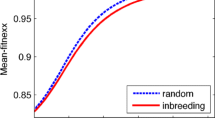Summary
Reason is given for doubting the validity of Hayman & Mather’s results on this question. Selection in favour of heterozygotes within lines slows down the onset of homozygosis, but cannot prevent it, if any homozygotes are allowed to breed. Similar selection between lines leads to different equilibria in different circumstances.
Similar content being viewed by others
References
Haldane, J. B. S. (1936). The amount of heterozygosis to be expected in an approximately pure line.J. Genet. 32, 375–91.
Hayman.B. I. (1953). Mixed selfing and random, mating when homozygotes are at a disadvantage.Heredity,7, 185–92.
Hayman, B. I. &Mather.K. (1953). The progress of inbreeding when homozygotes are at a disadvantage.Heredity,7, 165–83.
Hollingsworth, M. J. &Maynard-Smith, J. (1955). The effects of inbreeding on rate of development and on fertility inDrosophila subobscura.J. Genet. 53, 295.
Author information
Authors and Affiliations
Rights and permissions
About this article
Cite this article
Self-Fertilization, I., Haldane, J.B.S. The conflict between inbreeding and selection I. Sele fertilization. J Genet 54, 56–63 (1956). https://doi.org/10.1007/BF02981703
Issue Date:
DOI: https://doi.org/10.1007/BF02981703




